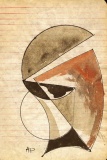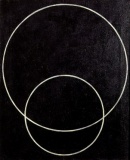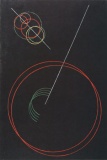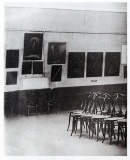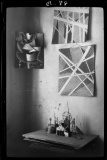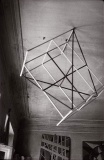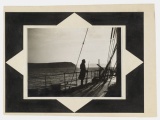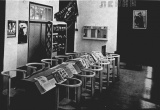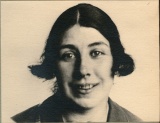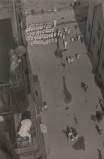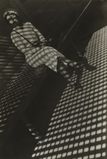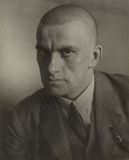Difference between revisions of "Alexander Rodchenko"
m (Text replacement - "{{SERVERNAME}}" to "monoskop.multiplace.org") |
|||
| Line 6: | Line 6: | ||
|birth_place = Leningrad, Russia | |birth_place = Leningrad, Russia | ||
|death_date = {{Death date and age|1956|12|3|1891|12|5|mf=y}} | |death_date = {{Death date and age|1956|12|3|1891|12|5|mf=y}} | ||
| − | |death_place = | + | |death_place = Moscow, Soviet Union |
}} | }} | ||
[[Image:Kaufman_Mikhail_1922_Rodchenko_standing_in_front_of_dismantled_hanging_spatial_construction.jpg|thumb|258px|Rodchenko standing in front of dismantled hanging spatial construction, 1922. Photo by [[Mikhail Kaufman]].]] | [[Image:Kaufman_Mikhail_1922_Rodchenko_standing_in_front_of_dismantled_hanging_spatial_construction.jpg|thumb|258px|Rodchenko standing in front of dismantled hanging spatial construction, 1922. Photo by [[Mikhail Kaufman]].]] | ||
| − | + | '''Aleksander Mikhailovich Rodchenko''' (Александр Михайлович Родченко; 1891–1956) was a Russian artist, sculptor, photographer and graphic designer. He was one of the founders of [[constructivism]] and Russian design. He was married to the artist [[Varvara Stepanova]]. | |
| − | == | + | ==Biography== |
| + | Born 1891 in St Petersburg to a working class family. 1909, after the death of his father his family moves to Kazan. Studies at the Kazan School of Art under Nikolai Feshin and Georgii Medvedev, and at the Stroganov Institute in Moscow. In Kazan school meets [[Varvara Stepanova|Stepanova]] whom he subsequently marries. 1915 first abstract drawings, influenced by [[Kazimir Malevich|Malevich]]'s Suprematism. 1916 participates in ''The Store'' exhibition organized by [[Vladimir Tatlin|Tatlin]], who was another formative influence in his development as an artist. 1917-18 designs the wall lamps for the Café Pittoresque. Late 1910s, produced "lineist" nonobjective canvases and linocuts, rejecting Kandinsky's thesis from his "On Line" essay (1919), in which he saw the line as "a highly revelatory material for primitive graphic expression." 1919-20 active member of [[Zhivskulptarkh]] experimental group. 1920 appointed Director of the Museum Bureau and Purchasing Fund (of the Museum of Painterly Culture, MZhK) by the Bolshevik Government, responsible for the reorganization of art schools and museums and acquisition of artworks on behalf of the Russian republic (between the summer 1918 and December 1920 the Bureau bought almost 2000 works of 400+ contemporary artists for 26 million rubels[http://books.google.com/books?id=KCJHxeNQuGMC&pg=PA66]). 1920 to 1930 teaches at [[VkHUTEMAS]]. 1921 joins Productivist group, which advocates the incorporation of art into everyday life. Gives up painting in order to concentrate on graphic design for posters, books, and films. Deeply influenced by [[Dziga Vertov|Vertov]], works with him intensively in 1922. Impressed by the photomontage of the German Dadaists, he begins his own experiments in the medium, first employing found images in 1923, and from 1924 on shooting his own photographs as well. 1923 his first published photomontage illustrates Mayakovsky's poem, ''Pro eto'' [About This]. 1923-28 collaborates closely with [[Vladimir Mayakovsky|Mayakovsky]] (of whom he takes several striking portraits) on the design and layout of ''[[LEF]]'' and ''[[Novy LEF]]'' journals; using many of his photographs as covers. Throughout the 1920s Rodchenko's work is very abstract. His images eliminate unnecessary detail, emphasize dynamic diagonal composition, and are concerned with the placement and movement of objects in space. 1930s, with the changing Party guidelines governing artistic practice, he concentrates on sports photography and images of parades and other choreographed movements. 1928 joins the [[October]] circle of artists but is expelled in 1931 being charged with "formalism". Late 1930s returns to painting, 1942 stops photographing. 1940s produces abstract expressionist works. 1940s continues to organize photography exhibitions for the government. Dies 1956 in Moscow. | ||
| + | |||
| + | ==Selected works== | ||
<gallery> | <gallery> | ||
File:Rodchenko_Alexander_1917-1918_Non-Objective_Composition.jpg|''Non-Objective Composition'', 1917-18. | File:Rodchenko_Alexander_1917-1918_Non-Objective_Composition.jpg|''Non-Objective Composition'', 1917-18. | ||
| Line 24: | Line 27: | ||
File:Rodchenko_Alexander_1925_Maquette_for_a_handbill_announcing_the_film_Potemkin.jpg|''Maquette for a handbill announcing the film Potemkin'', 1925, gelatin silver print and ink on paper. | File:Rodchenko_Alexander_1925_Maquette_for_a_handbill_announcing_the_film_Potemkin.jpg|''Maquette for a handbill announcing the film Potemkin'', 1925, gelatin silver print and ink on paper. | ||
File:Rodchenko_Alexander_1925_Soviet_Workers_Club.jpg|''Soviet Workers Club'', 1925. | File:Rodchenko_Alexander_1925_Soviet_Workers_Club.jpg|''Soviet Workers Club'', 1925. | ||
| − | File:Rodchenko_Alexander_undated_Portrait_of_Lyubov_Popova.jpg|'' | + | File:Rodchenko_Alexander_undated_Portrait_of_Lyubov_Popova.jpg|''Lyubov Popova'', n.d. |
File:Aleksander_Rodchenko_Assembling_for_a_Demonstration_1928-30.jpg|''Assembling for a Demonstration'', 1928-30. | File:Aleksander_Rodchenko_Assembling_for_a_Demonstration_1928-30.jpg|''Assembling for a Demonstration'', 1928-30. | ||
File:Alexander_Rodchenko_c_1934_Girl_with_a_Leica.jpg|''Girl with a Leica'', c. 1934. | File:Alexander_Rodchenko_c_1934_Girl_with_a_Leica.jpg|''Girl with a Leica'', c. 1934. | ||
| − | File:Mayakovsky-by-Rodchenko.jpg| Vladimir Vladimirovich Mayakovsky | + | File:Mayakovsky-by-Rodchenko.jpg|''Vladimir Vladimirovich Mayakovsky'' |
</gallery> | </gallery> | ||
==Literature== | ==Literature== | ||
| − | + | * Hubertus Gaßner, ''Alexander Rodschenko. Konstruktion 1920 oder die Kunst, das Leben zu organisieren'', Frankfurt am Main: Fischer, 1984. {{de}} | |
| − | + | * Selim O. Khan-Magomedov, ''Rodchenko: The Complete Work'', ed. Vieri Quilici, MIT Press, 1986, 303 pp. [http://www.jstor.org/stable/307072 Review]. {{en}} | |
| − | + | * Brandon Taylor, [http://www.tate.org.uk/research/publications/tate-papers/aleksandr-rodchenkos-lines-force "Aleksandr Rodchenko’s Lines of Force"], ''Tate Papers'', 2009. {{en}} | |
| − | + | * [http://media.wix.com/ugd//23892f_d0e3678f112f589c3cd50fa1473ef753.pdf Catalogue]. {{ru}} | |
| − | * Hubertus Gaßner, ''Alexander Rodschenko. Konstruktion 1920 oder die Kunst, das Leben zu organisieren'', Frankfurt am Main: Fischer, 1984. | ||
| − | * Selim O. Khan-Magomedov, ''Rodchenko: The Complete Work'', ed. Vieri Quilici, MIT Press, 1986, 303 pp. [http://www.jstor.org/stable/307072 Review] | ||
| − | * Brandon Taylor, [http://www.tate.org.uk/research/publications/tate-papers/aleksandr-rodchenkos-lines-force "Aleksandr Rodchenko’s Lines of Force"], ''Tate Papers'', 2009. | ||
| − | * [http://media.wix.com/ugd//23892f_d0e3678f112f589c3cd50fa1473ef753.pdf Catalogue]. | ||
==See also== | ==See also== | ||
* [[Varvara Stepanova]] | * [[Varvara Stepanova]] | ||
* [[Russia#Avant-garde]] | * [[Russia#Avant-garde]] | ||
| − | * [[ | + | * [[Central_and_Eastern_Europe#Constructivists.2C_Futurists|Central and Eastern Europe#Constructivists, Futurists]] |
| − | * [[ | + | * [[Central_and_Eastern_Europe#Photography|Central and Eastern Europe#Photography]] |
==Links== | ==Links== | ||
| Line 59: | Line 58: | ||
* [http://en.wikipedia.org/wiki/Alexander_Rodchenko Rodchenko on Wikipedia] | * [http://en.wikipedia.org/wiki/Alexander_Rodchenko Rodchenko on Wikipedia] | ||
| − | {{featured_article}} | + | {{featured_article}} {{DEFAULTSORT:Rodchenko, Alexander}} |
| − | {{DEFAULTSORT:Rodchenko, Alexander}} | + | [[Category:Constructivism]] [[Category:Productivism]] [[Category:Graphic design]] |
| − | [[Category:Constructivism]] | ||
| − | [[Category:Productivism]] | ||
| − | [[Category:Graphic design]] | ||
| − | |||
Revision as of 23:56, 31 July 2015
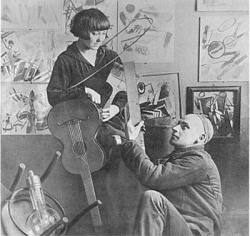 With Varvara Stepanova, 1920s. | |
| Born |
December 5, 1891 Leningrad, Russia |
|---|---|
| Died |
December 3, 1956 (aged 64) Moscow, Soviet Union |
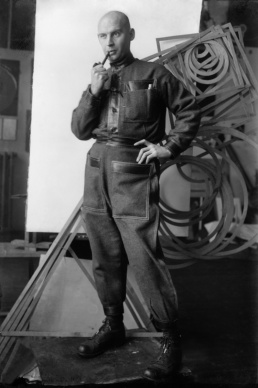
Aleksander Mikhailovich Rodchenko (Александр Михайлович Родченко; 1891–1956) was a Russian artist, sculptor, photographer and graphic designer. He was one of the founders of constructivism and Russian design. He was married to the artist Varvara Stepanova.
Biography
Born 1891 in St Petersburg to a working class family. 1909, after the death of his father his family moves to Kazan. Studies at the Kazan School of Art under Nikolai Feshin and Georgii Medvedev, and at the Stroganov Institute in Moscow. In Kazan school meets Stepanova whom he subsequently marries. 1915 first abstract drawings, influenced by Malevich's Suprematism. 1916 participates in The Store exhibition organized by Tatlin, who was another formative influence in his development as an artist. 1917-18 designs the wall lamps for the Café Pittoresque. Late 1910s, produced "lineist" nonobjective canvases and linocuts, rejecting Kandinsky's thesis from his "On Line" essay (1919), in which he saw the line as "a highly revelatory material for primitive graphic expression." 1919-20 active member of Zhivskulptarkh experimental group. 1920 appointed Director of the Museum Bureau and Purchasing Fund (of the Museum of Painterly Culture, MZhK) by the Bolshevik Government, responsible for the reorganization of art schools and museums and acquisition of artworks on behalf of the Russian republic (between the summer 1918 and December 1920 the Bureau bought almost 2000 works of 400+ contemporary artists for 26 million rubels[1]). 1920 to 1930 teaches at VkHUTEMAS. 1921 joins Productivist group, which advocates the incorporation of art into everyday life. Gives up painting in order to concentrate on graphic design for posters, books, and films. Deeply influenced by Vertov, works with him intensively in 1922. Impressed by the photomontage of the German Dadaists, he begins his own experiments in the medium, first employing found images in 1923, and from 1924 on shooting his own photographs as well. 1923 his first published photomontage illustrates Mayakovsky's poem, Pro eto [About This]. 1923-28 collaborates closely with Mayakovsky (of whom he takes several striking portraits) on the design and layout of LEF and Novy LEF journals; using many of his photographs as covers. Throughout the 1920s Rodchenko's work is very abstract. His images eliminate unnecessary detail, emphasize dynamic diagonal composition, and are concerned with the placement and movement of objects in space. 1930s, with the changing Party guidelines governing artistic practice, he concentrates on sports photography and images of parades and other choreographed movements. 1928 joins the October circle of artists but is expelled in 1931 being charged with "formalism". Late 1930s returns to painting, 1942 stops photographing. 1940s produces abstract expressionist works. 1940s continues to organize photography exhibitions for the government. Dies 1956 in Moscow.
Selected works
- Rodchenko Alexander 1920 Construction.jpg
Construction, 1920.
Literature
- Hubertus Gaßner, Alexander Rodschenko. Konstruktion 1920 oder die Kunst, das Leben zu organisieren, Frankfurt am Main: Fischer, 1984. (German)
- Selim O. Khan-Magomedov, Rodchenko: The Complete Work, ed. Vieri Quilici, MIT Press, 1986, 303 pp. Review. (English)
- Brandon Taylor, "Aleksandr Rodchenko’s Lines of Force", Tate Papers, 2009. (English)
- Catalogue. (Russian)
See also
- Varvara Stepanova
- Russia#Avant-garde
- Central and Eastern Europe#Constructivists, Futurists
- Central and Eastern Europe#Photography
Links
- Aleksandr Rodchenko at MoMA.org
- http://konstruktivizm.com/category/alexander-rodchenko
- Rodchenko & Popova exhibition in Tate London, 2009
- http://artblart.wordpress.com/2011/08/09/exhibition-alexander-rodchenko-revolution-in-photography-at-fotomuseum-winterthur-zurich/
- http://masters-of-photography.com/R/rodchenko/rodchenko.html
- http://calitreview.com/2842
- http://www.e-flux.com/journal/view/132
- http://www.chtodelat.org/index.php?option=com_content&view=article&id=558%3Aproductionism-art-of-the-revolution-or-design-for-the-proletariat&catid=204%3A01-25-what-is-the-use-of-art&Itemid=455&lang=en
- http://leb.nlr.ru/search/?scope=docs&query=Родченко
- Rodchenko's photographs
- Rodchenko on Wikipedia
